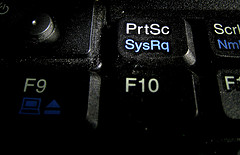How To Print Screen Directly To A File (Windows)
Mac lovers around the world have grown used to the handy functionality that is being able to print screen directly to a file. In Windows, rather than pressing a key combination to save the screen directly to a file, you instead have to use the ‘Print Screen‘ key (which copies the screen to the clipboard) and then open a image editing program, paste it in and save it.
Time consuming if you are doing a lot, and quite frankly, a complete pain!!
However, Microsoft have cottoned on to this, and although not necessarily a perfect implementation when compared to the OS X way of doing it, it’s definitely an improvement.
Firstly, the bad news, if you’re on Windows 7 or lower this ain’t going to work for you. Microsoft could in theory release a hotfix for it for Windows 7 but it’s probably not that high on their to do list.
Good news – if you’re on Windows 8 its all good!
How To Screenshot to a File
First thing to note is that the screenshot to a file on Windows is going to send it to your pictures folder (that’s the one in your user folder, next to (ish) documents). Not as convenient as the good old desktop implementation in OS X but livable!
Second thing to note – you can still just use the print screen (Prt Scr) key to print the screen to the clipboard, the same as usual – no change there.
But now for the awesomeness……
Using the key combination ‘ALT-PRT SCR‘ – thats the alt and print screen keys pressed together – will do the same as print screen but also save it in a file in your pictures folder.
It’s good to note at this point that ALT-PRT SCR also still copies it to your clipboard as well (no need to open the file and copy it manually).
And there you have it, another good OS X feature now making an appearance in Windows!
Image: solylunafamilia.




The same functionality has been available in Linux for years. Fn (function) + Pnt Sc opens a save dialog box where you can rename and save to any folder you wish, including desktop and make the setting you choose as default!
Nice to know the world’s largest software company is catching up with the freeware/Unix derivative community. Next they might make an OS the does what the consumer wants rather than what they want!!!
Haha, well yes, Microsoft have been known to not always be the first to cotton on to an amazing feature.
Sounds like the Linux implementation of this is possibly a bit more user friendly in the way that it allows the location to be chosen.
I do believe that this can be done on OS X as well, but you have to dig in to the config and find the setting – it doesn’t sound as accessible as the Linux implementation.
However, the OS X version is basically ‘point and press’ so I guess both the Linux and OS X implementation have their advantages.